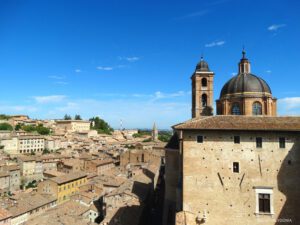The best travel experiences in Italy
Urbino Attractions: A Guide to Exploring the Renaissance Gem of Italy
Urbino, a charming city nestled in the Marche region of Italy, offers a unique blend of Renaissance history, architectural splendor, and cultural richness. Known as the birthplace of Raphael and celebrated for its historical significance, Urbino is a city that promises visitors a journey back in time to one of Italy’s most influential periods. This guide to Urbino attractions will help you uncover the city’s must-visit landmarks, hidden treasures, and cultural experiences that make it a true gem for travelers, historians, and art lovers alike.
1. Introduction to Urbino
1.1 Where is Urbino?
Situated in the central Italian region of Marche, Urbino is located in the foothills of the Apennine Mountains and surrounded by rolling countryside. Urbino is not only a city but a piece of history, offering an authentic Renaissance experience for all who visit.
1.2 The Historical Significance of Urbino
Urbino rose to prominence during the 15th century under the patronage of the Montefeltro family. Federico da Montefeltro, Duke of Urbino, was instrumental in shaping Urbino into a Renaissance center for art, architecture, and learning. Today, Urbino’s old town is recognized as a UNESCO World Heritage Site for its well-preserved historical architecture and cultural heritage.
2. Must-See Urbino Attractions
2.1 Palazzo Ducale: The Jewel of Urbino
The Palazzo Ducale, or Ducal Palace, is one of Urbino’s most iconic and historically significant buildings. Built by Federico da Montefeltro, this palace represents the pinnacle of Renaissance architecture in Urbino. The Palazzo Ducale houses the Galleria Nazionale delle Marche (National Gallery of the Marche), which displays an impressive collection of Renaissance art, including works by Piero della Francesca and Raphael.
2.1.1 Architectural Beauty of Palazzo Ducale
With its elegant courtyards, grand halls, and intricate frescoes, the Palazzo Ducale showcases the skill and creativity of Renaissance architects and artists. The Façade of the Torricini, the palace’s iconic twin towers, is an architectural masterpiece and an emblem of Urbino.
2.2 Casa Natale di Raffaello: Raphael’s Birthplace
Urbino is widely recognized as the birthplace of the renowned painter Raphael. The Casa Natale di Raffaello (Raphael’s Birthplace) is a small house-turned-museum that offers visitors a glimpse into the artist’s early life. Visitors can explore the rooms where Raphael grew up, view some of his early sketches, and learn more about his influences and inspirations.
2.2.1 Art and History at Raphael’s House
While the house itself is relatively modest, the Casa Natale di Raffaello holds great historical value. The museum displays a collection of Raphael’s early works, as well as artifacts from the period, making it an essential stop for art enthusiasts and history buffs alike.
2.3 Oratorio di San Giovanni Battista: A Hidden Gem
The Oratorio di San Giovanni Battista is one of Urbino’s lesser-known treasures but is a must-see for its impressive frescoes. Created by the Salimbeni brothers in the 15th century, the frescoes depict the life of Saint John the Baptist with vivid detail and emotion, showcasing the distinctive style of Gothic art.
2.3.1 Frescoes of the Oratorio di San Giovanni
The frescoes here are considered some of the finest in Italy, known for their expressiveness and detail. Visitors are often struck by the vibrancy of the colors and the lifelike quality of the figures. The Oratorio di San Giovanni is a true hidden gem that offers an intimate look at religious art in Urbino.
2.4 Oratorio di San Giuseppe: The Nativity Scene in Stucco
Another significant oratory in Urbino is the Oratorio di San Giuseppe, which houses a unique nativity scene made entirely of stucco. Created by Federico Brandani, the stucco work in this chapel is remarkable for its intricate details and lifelike figures.
2.4.1 Artistic Mastery in Stucco
The stucco nativity scene is one of the most distinctive works of art in Urbino, representing the religious and artistic devotion of the time. The figures are expressive and finely detailed, making the Oratorio di San Giuseppe a fascinating stop for anyone interested in religious art and Renaissance craftsmanship.
3. Exploring Urbino’s Old Town
3.1 The Layout of Urbino’s Historic Center
Urbino’s historic center is a UNESCO World Heritage Site that has preserved its Renaissance character over the centuries. The medieval streets are lined with brick buildings that reflect the city’s storied past, and visitors can enjoy wandering through the narrow alleys and discovering quaint squares.
3.2 Piazza della Repubblica: The Heart of Urbino
The Piazza della Repubblica is Urbino’s main square and a lively gathering place for locals and tourists alike. Surrounded by cafes, shops, and historic buildings, this square is an ideal spot to relax, enjoy a coffee, and soak in the atmosphere of this Renaissance city.
4. Religious Sites and Monuments
4.1 Urbino Cathedral
The Urbino Cathedral, also known as Duomo di Urbino, is a neoclassical structure that dominates the city’s skyline. Originally built in the 15th century and later reconstructed, the cathedral houses several important works of art, including paintings by Federico Barocci. The architecture of the cathedral is both imposing and elegant, making it one of Urbino’s key religious landmarks.
4.2 The Mausoleum of the Dukes
Located within San Bernardino Church, the Mausoleum of the Dukes is where Federico da Montefeltro and his descendants were laid to rest. This mausoleum is a solemn yet beautiful site, known for its serene atmosphere and historical significance.
5. Museums and Cultural Sites
5.1 Galleria Nazionale delle Marche
Housed in the Palazzo Ducale, the Galleria Nazionale delle Marche is one of Italy’s most important art museums. The gallery contains works by some of the greatest Renaissance artists, including Piero della Francesca, Raphael, and Paolo Uccello.
5.1.1 Highlights of the Collection
The gallery’s collection includes iconic pieces like The Flagellation of Christ by Piero della Francesca and La Muta by Raphael. Art lovers will find the gallery an invaluable experience, as it offers a comprehensive look at Renaissance art and culture.
5.2 Museo Diocesano Albani
The Museo Diocesano Albani houses a collection of religious art and artifacts from Urbino and the surrounding Marche region. The museum’s collection includes valuable liturgical objects, paintings, and sculptures, providing insight into the religious history of the area.
6. Outdoor Activities Around Urbino
6.1 Hiking and Nature Walks in Montefeltro
The Montefeltro area surrounding Urbino offers numerous opportunities for outdoor activities such as hiking, biking, and nature walks. The rolling hills and valleys provide scenic views and a chance to experience the natural beauty of Marche.
6.2 Exploring Nearby Villages
The Marche region is filled with charming hilltop villages that retain their medieval character. Villages like Urbania and Sant’Angelo in Vado are just a short drive from Urbino and offer a chance to explore traditional Italian life away from the bustle of major tourist spots.
7. Culinary Delights of Urbino
7.1 Traditional Marche Cuisine
Urbino offers a taste of traditional Marche cuisine, which emphasizes fresh, local ingredients. Some regional specialties include crescia (a type of flatbread), passatelli (pasta made with breadcrumbs and Parmesan), and porchetta (slow-roasted pork).
7.2 Where to Dine in Urbino
Urbino has a range of restaurants and trattorias that serve authentic Italian and Marche cuisine. Dining in Urbino is an experience that highlights the rich flavors and culinary traditions of the region, with many dishes influenced by the city’s historical past.
8. Practical Information for Visiting Urbino
8.1 How to Get to Urbino
Urbino is accessible by car, bus, or private transfer from nearby cities like Pesaro, Ancona, and Florence. While Urbino does not have its own train station, nearby cities provide connections that make it easy to reach Urbino by public transport or private transfer.
8.2 Guided Tours and Private Experiences
To truly appreciate Urbino’s history and cultural significance, consider booking a guided tour or a private walking experience with a local expert. These tours provide insights into the city’s history, architecture, and art that you might otherwise miss.
Book your Urbino private tour
You might also be interested in:
What Region is Urbino in? Discovering the Hidden Gem of the Marche Region
Urbino During the Renaissance: A Journey Through Art, Culture, and Power
Where is Urbino, Italy? A Complete Guide to the Location, History, and Travel Tips
Private Transfer Service NCC Rental Taxi: The Complete Guide to Traveling with Comfort and Style
Private Guide Urbino: Your Ultimate Guide to Exploring the City
Things to Do in Urbino: A Complete Guide to Italy’s Hidden Gem
Urbino, Italy: All You Must Know Before You Go
Servizio Privato Transfer/Noleggio NCC Taxi: La Guida Completa per Viaggiare con Comfort e Stile
Guida Turistica Urbino: Scopri la Perla del Rinascimento Italiano
Cose da Fare a Urbino: Guida Completa per Scoprire la Città Rinascimentale
Le Migliori 10 Cose da Vedere a Urbino: Una Guida Completa alla Scoperta della Città
Quanto Tempo Ci Vuole per Visitare Urbino? Guida Completa alla Scoperta della Città
https://en.wikipedia.org/wiki/Urbino
https://whc.unesco.org/en/list/828/
https://edition.cnn.com/travel/article/urbino-renaissance-town-italy/index.html



